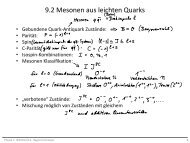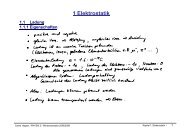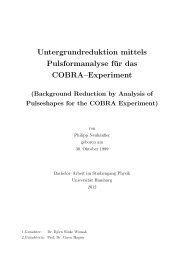Setup of a Drift Tube Muon Tracker and Calibration of Muon ...
Setup of a Drift Tube Muon Tracker and Calibration of Muon ...
Setup of a Drift Tube Muon Tracker and Calibration of Muon ...
Create successful ePaper yourself
Turn your PDF publications into a flip-book with our unique Google optimized e-Paper software.
Reco Hits in Scintillatory [mm]1000800600108400620040-2002-400-400 -200 0 200 400 600 800 1000x [mm]0Figure 5.15: Intersection <strong>of</strong> reconstructed events with the x−y-plane at z = 227mm.This plane represents the trigger scintillator layer. The single scintillators are representedby the black rectangles (compare Fig. 5.1). Tracks intersect the plane at theblack dots. The colored areas depict the number <strong>of</strong> tracks per 25cm 2 . One can clearlysee a lower density at the larger scintillators, especially the lower right one. Also, thetracks are not distributed homogeneously within all scintillators. This leads to theassumption that some <strong>of</strong> the scintillators are malfunctioning.smears out which is expected for inclined tracks. The number <strong>of</strong> hits then show ahomogeneous distribution for the second module <strong>of</strong> the plane. However, the averagenumber <strong>of</strong> hits <strong>of</strong> approximately 45 is below the according value <strong>of</strong> the y − z-plane,which has an average <strong>of</strong> 60 hits per tube. Since the latter plane is further away fromthe scintillator, less events would actually be expected here. This strengthens thehypothesis <strong>of</strong> a malfunctioning trigger scintillator. Scintillators C <strong>and</strong> D are spreadhomogeneously across the modules <strong>of</strong> the y − z-plane. Although they contribute toonly 22% <strong>of</strong> the trigger surface, they seem to account for the majority <strong>of</strong> events.Comparing the the peaks <strong>of</strong> the first module in the hitmap <strong>of</strong> the x − z-plane withthe level for the second module, one can estimate a reduction <strong>of</strong> the trigger rate byroughly a factor <strong>of</strong> three for the scintillators A <strong>and</strong> B. An efficiency <strong>of</strong> only one third<strong>of</strong> the two larger scintillators (accounting for 78% <strong>of</strong> the trigger surface) would leadto an overall efficiency <strong>of</strong> only 1 3× 0.78 + 0.22 = 0.48.The assumption <strong>of</strong> a poor trigger efficiency can be confirmed by consideringreconstructed tracks. The x <strong>and</strong> y coordinates at the level <strong>of</strong> the trigger plane (z =227 mm) were calculated <strong>and</strong> drawn in a scatter plot. The result is shown in Fig. 5.15.It shows the distribution <strong>of</strong> reconstructed tracks in the trigger scintillator plane.One can clearly see that the events are not distributed homogeneously. Obviously82





